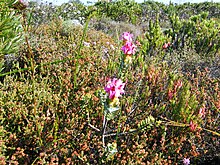
The Alismatales (alismatids) are an order of flowering plants including about 4,500 species. Plants assigned to this order are mostly tropical or aquatic. Some grow in fresh water, some in marine habitats. Perhaps the most important food crop in the order is the corm of the taro plant, Colocasia esculenta.
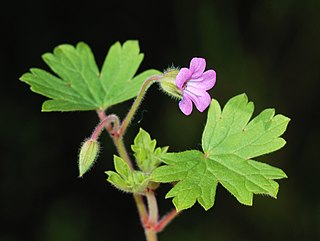
Geraniaceae is a family of flowering plants placed in the order Geraniales. The family name is derived from the genus Geranium. The family includes both the genus Geranium and the garden plants called geraniums, which modern botany classifies as genus Pelargonium, along with other related genera.

Haemodoraceae is a family of perennial herbaceous flowering plants with 14 genera and 102 known species. It is sometimes known as the "bloodroot family". Primarily a Southern Hemisphere family, they are found in South Africa, Australia and New Guinea, and in the Americas. Perhaps the best known are the widely cultivated and unusual kangaroo paws from Australia, of the two closely related genera Anigozanthos and Macropidia.

Olinia is a genus of small trees and shrubs with 10 species in the family Penaeaceae. The species of Olinia are native to Africa, ranging from west Africa to South Africa. It was previously regarded as the sole genus in the family Oliniaceae, but is now included in the expanded Penaeaceae along with Rhynchocalyx under the APG III system of classification.
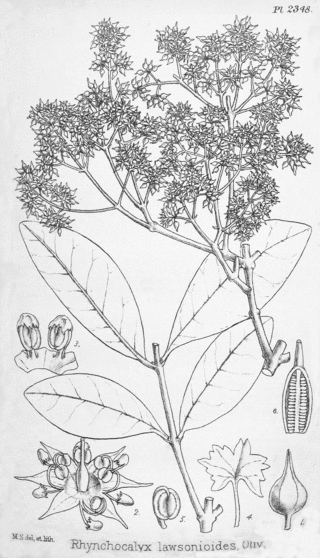
Rhynchocalyx lawsonioides is a small flowering tree, the sole species of the genus Rhynchocalyx. It had also previously been regarded as the only species in the monogeneric family Rhynchocalycaceae but is now included in the expanded Penaeaceae along with Olinia under the APG III system of classification. Rhynchocalyx is endemic to the KwaZulu-Cape coastal forest mosaic ecoregion of the Natal and Eastern Cape provinces of South Africa.

The Crypteroniaceae are a family of flowering trees and shrubs. The family includes 13 species in three genera, native to Indomalaya.
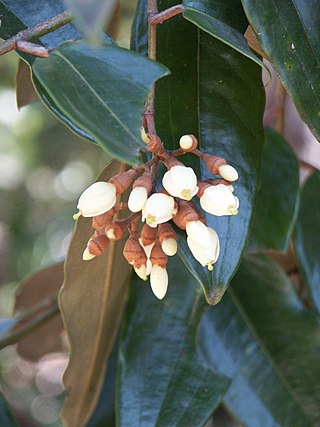
The Sarcolaenaceae are a family of flowering plants endemic to Madagascar. The family includes 79 species of mostly evergreen trees and shrubs in ten genera.

Gelsemiaceae is a family of flowering plants, belonging to the order Gentianales. The family contains only three genera: Gelsemium, Mostuea and Pteleocarpa. Gelsemium has three species, one native to Southeast Asia and southern China and two native to Central America, Mexico, and the southeastern United States. The eight species of Mostuea are native to tropical areas of South America, Africa, and Madagascar. The two genera were formerly classified in the family Loganiaceae. Pteleocarpa was originally placed in Boraginaceae or in its own family Pteleocarpaceae, but it is most closely related to Gelsemiaceae with which it shares significant characters.

Pedaliaceae, the pedalium family or sesame family, is a flowering plant family classified in the order Lamiales. The family includes sesame, the source of sesame seeds.
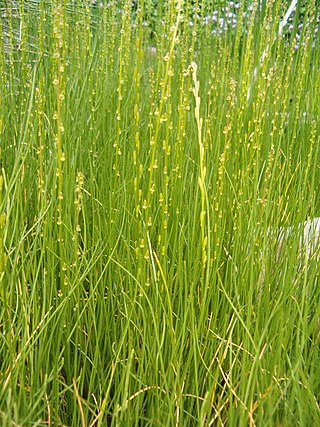
Juncaginaceae is a family of flowering plants, recognized by most taxonomists for the past few decades. It is also known as the arrowgrass family. It includes 3 genera with a total of 34 known species.

Melanophylla is a genus of flowering plants endemic to Madagascar. The genus contains seven species of small trees and shrubs.
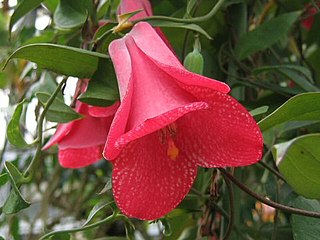
Philesiaceae is a family of flowering plants, including two genera, each with a single species. The members of the family are woody shrubs or vines endemic to southern Chile.

Lanaria is a monotypic genus of flowering plants containing a single species, Lanaria lanata, endemic to the southern coast of South Africa where it is associated with the fynbos belt. Lanaria lanata is commonly known as Cape edelweiss or lambtails. The genus is placed in the monotypic family Lanariaceae, a family only recently recognized by taxonomists. The APG IV system of 2016 does recognize this family.
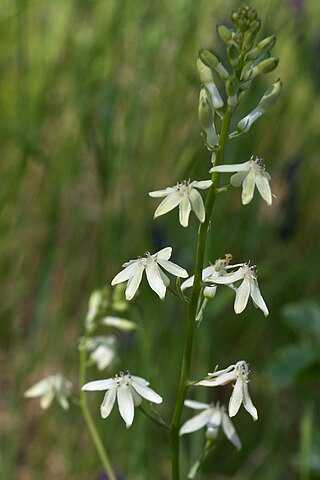
Tecophilaeaceae is a family of flowering plants, placed in the order Asparagales of the monocots. It consists of nine genera with a total of 27 species.

Medusandra is a genus of flowering plants in the family Peridiscaceae. It has two species, Medusandra richardsiana and Medusandra mpomiana. M. richardsiana is the most common and well known. Both species are native to Cameroon and adjacent countries.
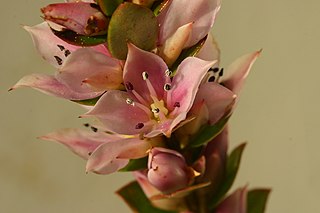
Geissoloma is a genus of flowering plants in the monotypic family Geissolomataceae, native to the Cape Province of South Africa. Geissoloma marginatum is the only species in the family. It is sometimes called guyalone in English. The plants are xerophytic evergreen shrubs and are known to accumulate aluminum.
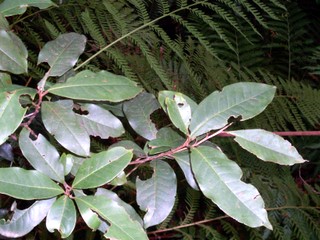
The Paracryphiaceae are a family of woody shrubs and trees native to Australia, southeast Asia, and New Caledonia. In the APG III system of 2009, the family is placed in its own order, Paracryphiales, in the campanulid clade of the asterids. In the earlier APG II system, the family was unplaced as to order and included only Paracryphia.

The Torricelliaceae are a family of trees native to Madagascar and southwest Asia. It contains three genera, Aralidium, Melanophylla and Torricellia. Under the APG II system, each of these genera was placed in its own family, but with the proviso that "Some of the families are monogeneric and could possibly be merged when well-supported sister-group relationships have been established." Such a relationship was established for these three genera in 2004. In the APG III system, these three genera constitute the family Torricelliaceae.

Huaceae is a family of plant in the rosids group, which has been classed in the orders Malpighiales, Malvales, and Violales or in its own order Huales. The APG II system placed it in the clade eurosids I, whereas the APG III system of 2009 and APG IV (2016) place it within the Oxalidales. The family is endemic to central Africa. It contains four species in the following two genera:
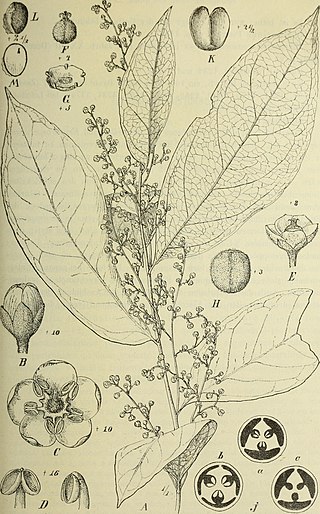
Centroplacaceae is a family of flowering plants in the order Malpighiales and is recognized by the APG III system of classification. The family comprises two genera: Bhesa, which was formerly recognized in the Celastraceae, and Centroplacus, which was formerly recognized in the Euphorbiaceae, together comprising six species. The Angiosperm Phylogeny Group determined that based on previous phylogenetic analysis, these two genera formed an isolated clade and recognition of the family was "reasonable."
